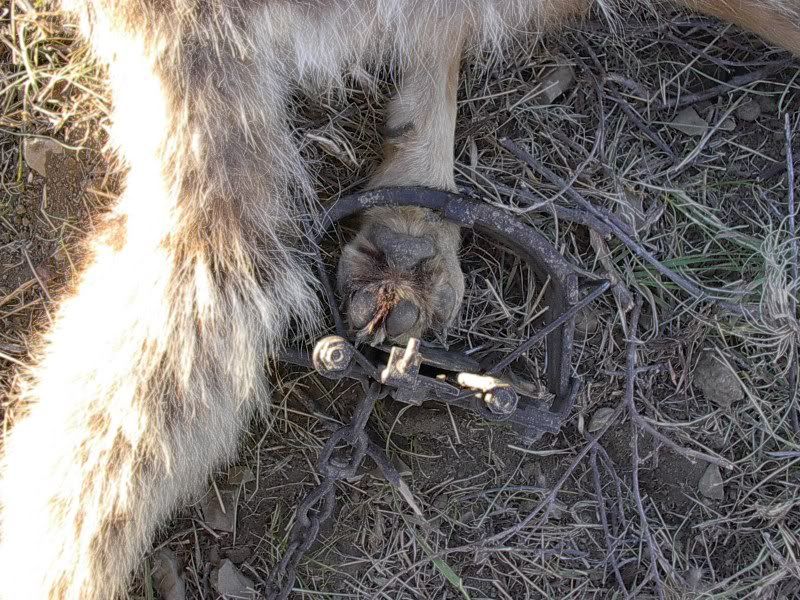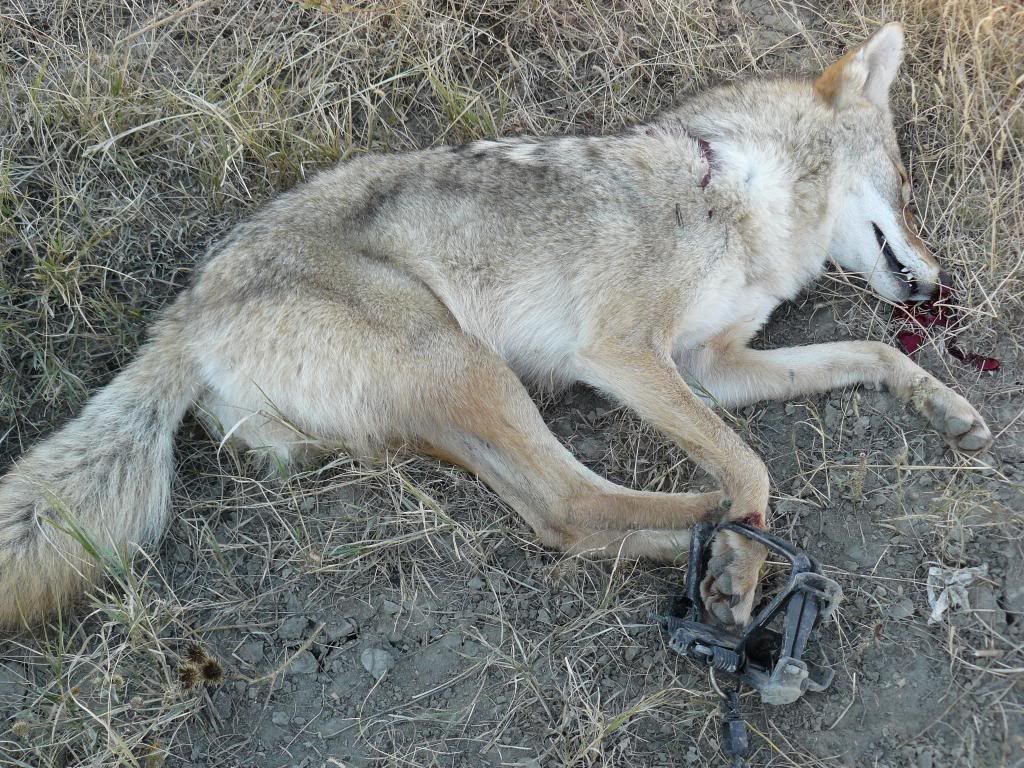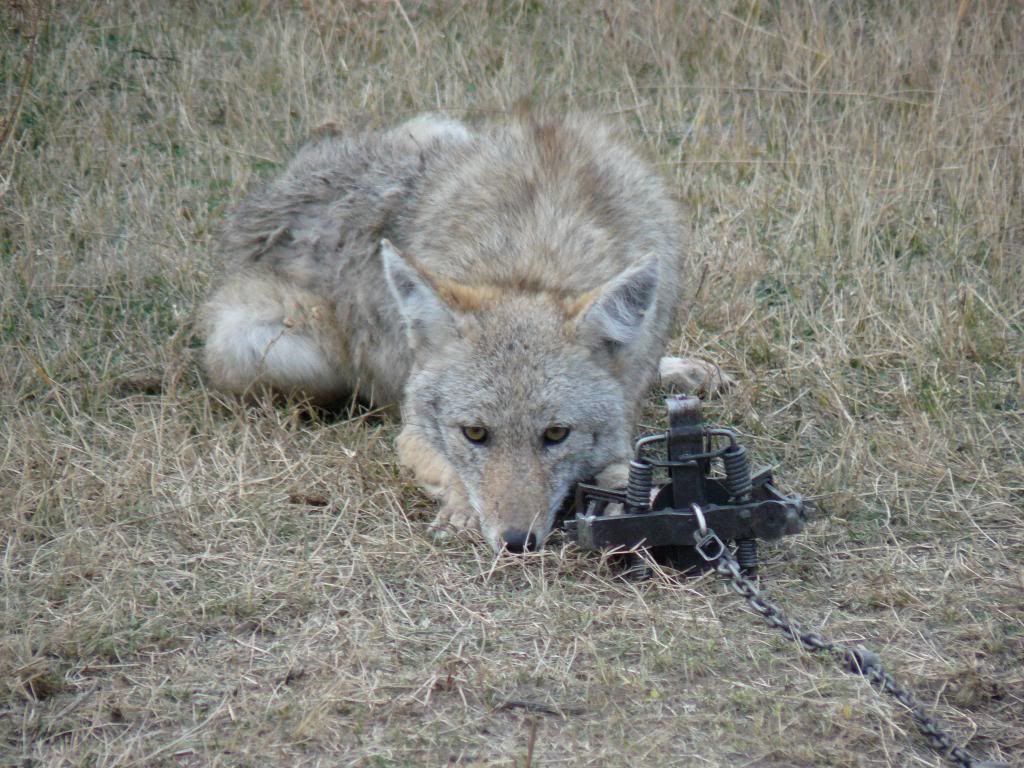|
|
Post by trappnman on Dec 31, 2012 8:10:23 GMT -6
PS- the screen I used last year, was bought at menards, and its the black aluminum screen
|
|
|
|
Post by trappincoyotes39 on Dec 31, 2012 8:59:25 GMT -6
OK took a few photos and to clarify I'm NO expert with dogless or screen as neither are my preference BUT, I think we are talking a small amount difference between pan heights and not talking major differances, I can get the pan so low on a Montana it hangs on the shank while setting with out too much severe bending but I just wanted them below the jaws as I don't like high pans. So take a look at a few photos of a montana this is where I adjusted them, hardly use a couple I have, more just to add to the collection. If I where goign to a dogless I would want a tad more jaw space for coyotes anyhow. Nick the monty's I'm sure lay perfect level and lower but are we talking a 1/16th, 1/8th or 1/4" differance in height? I think if the Montanas had a tad longer shank they would be more level ?  Pan height in relation to framehump for spring pin: Not alot there.  jaws and pan below level  |
|
|
|
Post by trappincoyotes39 on Dec 31, 2012 9:03:35 GMT -6
You screen guys have at it  I like talking traps and adjustments. |
|
|
|
Post by trappnman on Dec 31, 2012 9:27:03 GMT -6
the pan sitting where it does on the montanas doesn't bother me in the least, as long as its level. The dukes , esp 1.5s also sit slightly above jaw level- only if using screens does it become a concern, and even then, only with unforgiving screen.
I don't know why anyone using traps #2 size and up, don't use screens, unless there is a mechanical feature of the trap that prevents it
can't be any quicker, can't be any better- and if using #3 traps, you are GOING to have tracks inside that jaw spread sooner or later.
I like to think I'm pretty good at guiding, having used 1.75s for many, many years- but guiding, is only designed to get their foot inside the trap jaws- on wider jaw traps, there IS room to step between dog and pan and sooner or later, its gong to happen. I used poly with 1.75s and found nothing better for THAT trap than poly- but going to the montanas, using poly, I lost coyotes simply because I didn't use a screen. So for the cost of screens ($19 for a years supply) why not use them?
|
|
|
|
Post by trappincoyotes39 on Dec 31, 2012 9:49:50 GMT -6
If you think screen is needed so be it, If I saw what you described thru the years I would do something different, but that isn't a concern for me. Jakes,Sterlings, Bridgers, coyote cuffs, these are the traps I have used for coyotes and sterlings for many years I just didn't see where I had the one track inside the jaw frame and No coyote very often.
Guiding, pan location to attractant, the pattern itself all play into it. Coffee filters are pretty darn quick! Guiding does bring there foot inside the traps jaws, the rest determines the catch.
I never liked anything under the pan itself.
Each to his own I guess?
|
|
|
|
Post by trappnman on Dec 31, 2012 10:05:15 GMT -6
you are telling me, using coffee filters, you never had a track inside the jaws?
|
|
|
|
Post by trappincoyotes39 on Dec 31, 2012 11:17:37 GMT -6
Note the word very often. Never? Nope can't say that. Enough to think screen would be a benefit to me? Nope to that account either. The number of prints inside my trap jaws where I thought screen would have MADE the difference is very low, very low. Remember the pan tension I like is more than most I want good deep solid holds. This is the norm doing what I do and have done for years it works for ME:Good gun notches but a pain to file- takes time so switch to PIT's same end result. Pan size in correlation to inside jaw spread makes a difference, we have been over the kill area thing before. I have caught pups to adults using NO screen.   PIT pans same results  |
|
|
|
Post by trappincoyotes39 on Dec 31, 2012 11:25:54 GMT -6
alot of what we do at the set makes a differance in foot placement.
No different than calling: terrain,wind, where you place caller all has an effect alot of times where the coyote approaches from and where he stops.
|
|
|
|
Post by trappnman on Dec 31, 2012 11:39:26 GMT -6
I can post pics too, but that doesn't prove anything either way, does it? its just showing whats caught, not what wasn't
you have told me that most of your coyote work was sheep killers, etc and that you couldn't afford to miss one. Even at a low %- and it was certainly a low % for me as well- but since I did all the work, why involve luck- if after a sheep killer, misisng even would would be detremental to the program
and yes, sure trap placement, design of set, etc aids in foot placement- TO THE TRAP but on wider jawed traps, you increase the space-sure, wider pans but screen is in effect a wider pan
I'm curious thoguh as to why you prefer coffe filters over screen. I've tried many pan covers- coffee filters, brown paper towels, wax paper, plastic wrap, a big leaf, even toilet paper, and found faults with each. Note I had no preconcienced notions- I tried them all. and decided for me, that pan covers that were flimsy, did nothing more than keep an open space under the pan, and if that was the objective then why bother with a cover, when it was far easier ot put something under the pan.
and I tried lots of things under the pan as well- and concluded, again for me, that poly was the ticket- odorless, cheap, resisted moisture and used that for a lot of years, still do on 1.75s
when I went to the montanas, I tried screen went away from screen, went back to screen etc- and after all that, I could see that not only was screen the easiest of anything but I got more coyotes with it-
have you used screens much and if so, why did you go away from them?
|
|
|
|
Post by trappincoyotes39 on Dec 31, 2012 11:59:36 GMT -6
The pics I have of prints on a pattern with no coyotes is well very little in fact I would have to look through a pile to find one or two.
Tman I think your missing it, IF I had troubles with livestock killers in traps I would switch to something better, YOU think screen is better I don't. Others who have trapped coyotes for a living on livestock some of them don't use screen either. Glen SR didn't use screen when employed either doing the same work.
Livestock killers require more than just a leg hold trap, calling and snares are a big portion as well. I could show pictures of coyotes I have caught that where killing livestock in traps and methods I use, I can't show you the ones that I missed because I didn't have screen, that number would be very low, can anyone claim 100%? I don't think so.
My methods work or I would change, my pictures where to show that I worked on excellent holding ability when the trap went snap, as pinching a coyote is far worse than him working past set 1 and getting caught in set 2,3 or 4 or a fence snare or called in and shot.
I have tried the Sterling's with enlarged pans that was an OG idea it was a poor one IMO and others, I had more toe caught coyotes than with the standard pan because of them, think of it as really stiff screen I didn't like the outcomes.
The point is to try and center the foot to be on the pan isn't that was trapping is all about? I want to limit hit and miss as much as I can, not worry about a very low % of coyotes that dink around inside of the jaws, realistically that is a small concern of mine because of it being so rare.
If you think the screen is great then so be it. I think my coffee filters are great as well. Some use smaller traps other use larger, some like screen others prefer a different cover, some like standard pans, some like others.
Gary Jepson is another who I believe has used filters as well and he traps in all kinds of weather.
Each to his own. Bottom line why change if it works right?
I mean think about the avg coyote foot and stride of one working a set, with guiding and other things I can do at the set him/her getting 1 track inside the jaws of my traps that is a firm step without setting off my traps? That is a really low number and one darn lucky coyote for sure, it just doesn't happen often enough to worry about that is a fact.
|
|
|
|
Post by trappnman on Dec 31, 2012 12:10:18 GMT -6
I'm confused- you say you HAVE had tracks inside the pan- not often, but you have.
correct?
so have you just been lucky in predation work to never have such occur, or do you use "something better" on ADC calls?
I do need to ask- why do you feel one way on push/pulls (saying if anything gives you an advantage you'll take it) and, even though you have had tracks, and screens eliminate tracks- you still don't use them?
when I used more 1.75s- I had tracks on the jaws occasionally- and my thought was- so what, I'll catch him later
and with the #3s w/o screens, I occasionally had a track inside the jaws- and since I now had a tool that didn't make me catch them later, I saw the value.
I can see using whatever, but looking at it from every angle- screen is the ultimate pan cover- whats the downfall?
|
|
|
|
Post by trappincoyotes39 on Dec 31, 2012 12:16:36 GMT -6
Because that something better doesn't HAVE to be screen. If that something better can get his/her feet moving more across my trap more that would be better to would it not?
2. We are dealing with wild animals and we can only control so much. Nothing is 100% back to that 99% or 99.6% thing again.
I like to pack my traps in firm and tight inside and outside the jaws always have and I suppose always will.
|
|
|
|
Post by Zagman on Dec 31, 2012 15:30:11 GMT -6
Some traps just have the right-sized pan in comparison to their jaws right from the factory......screen is not needed as a kill area expansion device on all big traps.
Screen as pan cover has other benefits for sure.....but don't think all big traps need screen to prevent the dreaded paw in the pattern...........some manufacturers have addressed this with pan correctly sized.
When OG himself teamed with Glenn Sterling on the MJ 600 prototype with the FULL PAN inside the jaws, they quickly dismissed it due to all the toe catches. If you have never seen this trap, the pan took up about 95% of the space within the jaws.
Black steel screen from OG on a Monty/Montana increases the kill area, but even then, its not all 95% of the space within the jaws.
Using aluminum or fiberglass decreases the kill area even further than stiff steel screen. Set some traps on your work bench and push down on that softer screen with a screwdriver to see for yourself......(of course, proper pan modification, etc effects the tension)
Screen has many advantages as a cover...........most of the discussion here does not address those attributes, but rather, addresses the expanded kill area.
PIT pans, Jake pans, Sterling pans, SC #3 and #4 pans, MB pans, etc.....are all properly sized that increasing the kill area with steel screen is either impossible or not necessary or both..............and I've used all the above myself....
Just my 13 cents.........
MZ
|
|
|
|
Post by trappincoyotes39 on Dec 31, 2012 16:32:50 GMT -6
Great points Zags some I tried to make in a round about way, you cut to the chase on a few of them!
No Tman I don't have something special for ADC calls, I use what works for ADC or fur to a very high degree, read Zags post and you can see why screen isn't a NEED for ME. I change things by using a proper pan to jaw ratio and if the trap doesn't have it I make it better by additions like the very reason I like the PIT pans.
As Zags stated softer screen doesn't help with kill area as it gives alomost like my coffee filter material. So with softer screen alum or fiber your gaining next to little for your kill area and prints inside the jaws.
Screen helps with moisture that is a plus, doesn';t let small particals filling in around the pan etc. It has some benefits as Zags mentioned but there are ways around those too.
You had more issues from 1.75's because of trap and pan size together, your taking a small jaw spread and adding a larger pan , looking at a coyotes foot and stride size stands to reason they aren't as efficant as a larger trap, hence many who start out with them go with a BETTER coyote trap down the road. Harder to get a coyote to step on a dime than a silver dollar. Even harder to get them to hit the center of a dime than a silver dollar.................
PUsh/PULL adds a much larger mathmatcial advantage to a trap, I'm thinking 50% as you can go either up or down versus just UP! Screen doesn't if your incorperate the things Zags and I have mentioned. YOur advanatge is far less when using a trap that has a pan to jaw ratio that makes it highly unlikely for a coyotes to take a full firm step inside the jaws without tripping the trap.
YOU and some others may think screen is the ulitmate pan cover for a 3 which the Montana is only in number by the way, closer to a 2 bridger than a 3 sized coilspring.
I guess all I can tell you is use sterlings and PIT on Bridger 3"s and then take even a smallish coyote foot and see how it can fit inside the jaws without making the trap fire...............
Again guiding, construction and a few other things can make that soo low it isn't a worry at all.
Nothing is 100% but I'm close when I use sterlings, Jakes or Bridgers with PIT pans and proper pan tension for coyotes.
Again use what YOU feel is goof for you and the traps YOU use and others will do the same.
Remember ultimate is a strong word. I don't think it fits this debate.
|
|
|
|
Post by trappnman on Dec 31, 2012 16:33:44 GMT -6
I'll have to disagree with the aluminum screens- cutting it wider, makes it tight and trust me you don't want to push down on it. if the screen was loose, I could see it doing what you describe
I'll be honest, when lori brought the screen home, I said "that won't work" but after a few days it was "good score!"
|
|
|
|
Post by ksboy2 on Jan 11, 2013 9:17:17 GMT -6
i have experimented quite a bit this year with pan coverings.... i had always used poly under on my tanas... but it draws moisture when wet then freezes.. don't like that... this year i have been using waxed paper... i pull off a length from the roll and cut it lengthwise into 1/3s... roll that and put it in a small ziplock bag in my back pocket... pull out, tear off about 6" of it.... wad it up then straighten back out... lay it right over the pan and make sure the loose jaw lays over the edge of it... flip the loose jaw back down and bed as normal... when you bed a tana trap it is a good idea in my opinion to build up the dirt under the loose jaw just a bit to raise it.... you can adjust your pan easily with a screwdriver to set lower just make sure you do not over adjust so it bottoms out before it fires... hope this helps... i do not like the metal screens here where i trap because it is sand and it tends to sift down through the wire and leave a visible depression around the pan...
|
|
|
|
Post by Possum on Jan 11, 2013 9:55:37 GMT -6
KSBOY2:
I use wax paper exclusively and mostly #4 Sleepy Creeks which zagman says has a properly sized pan. My point however, is instead of using the waxed paper as you describe, try this. Take the roll of paper out of the box and use a saw (table saw, hand saw, whatever-saw) to cut the roll into the width you need. Put the shortened roll in your bucket or tool kit. Now all need to do is unroll and rip off the proper length. Way easy.
|
|
|
|
Post by trappnman on Jan 11, 2013 10:01:24 GMT -6
with poly, the reason you have trouble with it freezing, is that you are using too much- a wad is too much. instead, pull off a very small piece, and spider web it out- all you need is enough under pan to create an air space- Poly does resist moisture quite a bit (compared to say cotton with absorbs it readily) and I use it when using 1.75s, and with that method have never had it freeze up so it inhibits pan drop.
|
|
|
|
Post by trappincoyotes39 on Jan 11, 2013 17:35:41 GMT -6
I don't like anything under a trap pan but above it.
|
|
|
|
Post by trappnman on Jan 11, 2013 19:13:05 GMT -6
you already have air undr the pan- the wisp of poly is pretty much just added air- eliminates the use or need of anything over the pan. why everyone not wanting to use screen doesn't try poly is beyond me
|
|